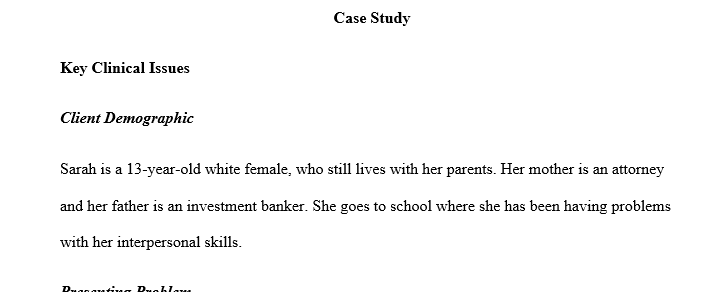The purpose of the Case Presentation assignments is to give you experience with applying theoretical principles of child and
Case Presentation Assignment Instructions
Overview
The purpose of the Case Presentation assignments is to give you experience with applying theoretical principles of child and adolescent psychopathology to real-world situations. An additional aim is to practice building a logical rationale for ascribing diagnoses using available information. A final goal is to foster critical thinking skills regarding the connection between causation and treatment of mental illness.
To complete each Case Presentation assignment, you will read the assigned case file and then use the information provided in the case file, the textbook (and/or other scholarly sources), and the current edition of the DSM to address the following 4 major topics: (1) Key Clinical Issues, (2) Diagnosis, (3) Etiology of the Problem/Disorder, and (4) Treatment Recommendations.
Before beginning these assignments, please review the Case Presentation Sample and its associated Sample Case File to get an idea of assignment expectations.
Instructions
Content Requirements
- Include a title page, 4–5 pages of expository content, and a references page.
- IMPORTANT: Follow the Case Presentation Template as a comprehensive guide for both the content and organization of your case presentations.
- Below is a brief overview of the content to be included in each case presentation. When writing your case presentation, please use the specific directions provided in the Case Presentation Template to fully and succinctly address the required content for each major section of the case presentation.
- Key Clinical Issues
- Client Demographics: Include a summary of demographic characteristics (e.g., age, gender, race/ethnicity etc.)
- Presenting Problem: Summarize information about the problem(s)/disorder(s) that the client reports, the history of the problem(s), and why he/she came for help. Be sure to briefly review the results of any relevant testing,
- Diagnosis
- Diagnostic Impressions: Based on the information provided in the case file and on the diagnostic criteria from the current edition of the DSM, write a sentence or two to identify every plausible disorder the client might be experiencing. identify all potential disorders, including the one you think it is.
- Differential Diagnosis: For all disorders from your list of diagnostic impressions, rule out the ones that cannot be justified by identifying the specific diagnostic criteria from the DSM that the client DOES NOT meet, which rule out the disorder
- Full DSM Diagnosis: Identify the final diagnosis that you have selected after ruling out the other possibilities. To build an argument in support of your diagnosis, briefly describe each diagnostic criterion in the current version of the DMS for the chosen disorder in your own words, and then use specific examples from the client’s case file to demonstrate how he/she meets each one.
- Etiology of the Problem/Disorder
- Biological Theory: Identify ONE biological theory of causation (or maintenance), and then cite information from the case file AND at least one scholarly source to support your rationale. If you cannot justify the theory using case information, then explain what additional information you would need to support your theory for the current case.
- Psychosocial Theory: Identify ONE psychosocial theory of causation (or maintenance), and then cite information from the case file AND at least one scholarly source to support your rationale. If you cannot justify the theory using case information, then explain what additional information you would need to support your theory for the current case.
- Treatment Recommendations
- Biological Intervention: Discuss ONE biological treatment you would use to address the biological cause that you identified. When making your treatment recommendation, make sure that it: 1) directly addresses the biological causal theory presented in the Etiology section, 2) is relevant to the case, 3) is able to be implemented by the client, and 4) is supported by at least one scholarly source.
- Psychosocial Intervention: Discuss ONE psychosocial treatment you would use to address the psychosocial cause that you identified. When making your treatment recommendation, make sure that it: 1) directly addresses the psychosocial causal theory presented in the Etiology section, 2) is relevant to the case, 3) is able to be implemented by the client, and 4) is supported by at least one scholarly source.
- Key Clinical Issues
Formatting Specifications
- In-text citations are provided and formatted according to current APA guidelines.
- All text is typed and double-spaced in a standard, university-approved font.
- All pages utilize 1-inch margins.
- A current APA-formatted title page is provided.
- A current APA-formatted references page is included.
- Individual references on the references page are formatted according to current APA guidelines.
- Sources on the references page match sources cited in the body of the paper.
Writing and Organization
- Write in a scholarly writing style with a formal, graduate-level tone
- Be concise, not wordy
- Organize your ideas logically
- Utilize appropriate grammar, diction and punctuation
Answer preview for The purpose of the Case Presentation assignments is to give you experience with applying theoretical principles of child and

1166 Words